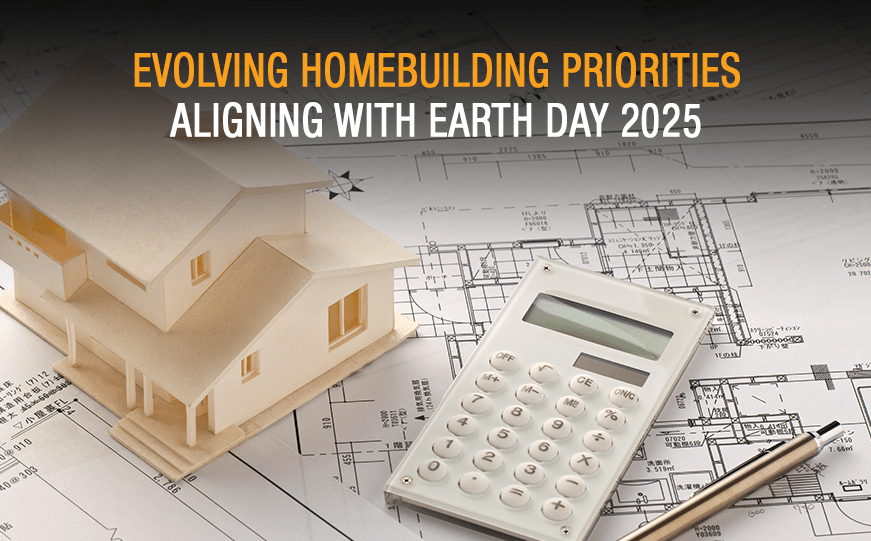The homebuilding marketing landscape is transforming with channel expectations shifting towards personalization, wellness and resilience. As we recognize “Our Power, Our Planet” theme from Earth Day this week, audiences are prioritizing homes that align with their values: efficiency, tailored relevance, wellness-oriented features and long-term sustainability.
These shifting expectations are borne out by statistics and polling. In fact, Builder Magazine last week detailed a new report titled, “The rise of joy-driven renovations” found 76% of homeowners are designing their homes for themselves… rather than considering what future buyers may be considering. The majority (84%) of homeowners are prioritizing projects — that bring happiness over dollars — including 68% of those who are planning to sell.
These changing priorities are redefining home design… while creating new opportunities for building product manufacturers and marketers to connect with architects, builders and developers.
For Building Product Brands to remain competitive, it is essential to integrate these four principles into product offerings. And into marketing strategies. By doing so, they can meet technical specifications while resonating with the modern homeowner’s evolving expectations.
Efficiency Over Excess
Today’s buyers seek energy-efficient designs, sustainable materials and cost-effective solutions that minimize environmental impact. Products that contribute to this efficiency — such as advanced insulation, energy-saving windows and smart home technology — are increasingly in demand.
One prominent example is the rise of net-zero energy homes. Builders are incorporating solar panels, high-performance HVAC systems and advanced building envelopes to minimize energy consumption. These homes not only lower utility costs… but also appeal to environmentally conscious consumers. Lennar’s 2023 “Net Zero Next Gen” homes exemplify how efficiency can differentiate its brand while catering to sustainability-focused buyers.
Another is Passive House which originated in Germany and is growing in popularity throughout the world. It’s a voluntary standard for energy efficiency that reduces the building’s carbon footprint based on five principles: airtightness, ventilation, waterproofing, heating/cooling and electrical loads. In the US these standards are being promoted by two separate entities: the Passive House Institute (PHI) and the Passive House Institute US (PHIUS).
For homebuilder marketing efforts, emphasizing cost savings, environmental benefits and long-term value of efficient building solutions continue to grow in importance. Highlighting real-life applications and measurable outcomes — such as reduced utility bills and improved energy performance — can help products stand out in an increasingly eco-conscious market.
Relevance Over Trendiness
While aesthetics remain important, relevance has overtaken trendiness as a key consideration for the homebuilding channel. Rather than anticipating the latest design trends, audiences are prioritizing features and amenities that cater to their unique lifestyles. Generic solutions will no longer suffice. Homeowners expect personalized, functional spaces that adapt to their values.
Builders are responding by offering modular and customizable design elements… including adjustable lighting, flexible space dividers and tailored storage solutions. For instance, KB Home’s “Built to Order” approach allows buyers to customize floor plans and design features based on their specific needs and budgets. This personalization fosters stronger emotional connections with floorplan features.
Marketers must emphasize how building products enable customization — supporting homeowners in creating spaces — that reflect their individuality. For luxury home marketing, highlighting tailored solutions that cater to aspirational buyer preferences, will further enhance a product’s appeal.
Wellness as a Design Cornerstone
Wellness has emerged as a critical consideration in home design. Factors such as indoor air quality, natural light and the use of non-toxic materials play a pivotal role in creating spaces that promote physical, mental and emotional well-being. As homeowners grow more aware of how their living environments impact their health, wellness-oriented features are becoming essential… rather than optional.
The International WELL Building Institute (IWBI) introduced the WELL Building Standard to evaluate how buildings influence health and well-being. This standard is gaining traction among builders and product manufacturers seeking to align with wellness-focused trends. For example, in 2022, Taylor Morrison became the first US homebuilder to achieve WELL certification for a single-family home community… integrating features like air purification, ergonomic designs and biophilic elements.
Building product marketers can enhance their messaging by showcasing how their products contribute to healthier living environments. For example, emphasizing improved indoor air quality, reduced noise levels and optimized natural lighting. Aligning with recognized wellness standards like those recommended by Wellness Within Your Walls (WWYW) further strengthens credibility and trust.
Resilience as a Rising Priority
As climate change intensifies, resilience has become a central focus in home construction. Architects and builders alike are prioritizing solutions that can withstand extreme weather events — from hurricanes and floods to wildfires — and maintain structural integrity over time. Products such as impact-resistant windows, fire-retardant materials and reinforced foundations are increasingly being prioritized.
Companies like Owens Corning are leading the way with roofing systems designed to withstand severe weather, while durable materials like concrete and steel are becoming staples in disaster-prone regions. For marketers, demonstrating the resilience of building products with compelling evidence — such as case studies or testimonials from regions affected by extreme weather — can significantly boost appeal.
Highlighting how resilient products protect homeowner investments and provide peace of mind is a key strategy for effective homebuilding marketing campaigns.
Best Practices for Marketing Building Products in a Changing Landscape
To succeed in today’s homebuilding market, successful marketers are adapting their strategies to align with evolving consumer priorities:
- Highlight Efficiency: Showcase how products reduce energy consumption, lower utility costs and support sustainability goals. Incorporate data and real-life project profiles to demonstrate tangible benefits.
- Emphasize Personalization: Highlight how products can be tailored to meet the specific needs of homeowners… especially in the context of relevance and functionality.
- Promote Wellness Benefits: Focus on health-oriented features, such as air quality improvements, biophilic design elements and non-toxic materials. Promoting wellness certifications will contribute to a brand promise and its credibility.
- Demonstrate Resilience: Provide clear evidence of a product’s durability and ability to withstand environmental challenges. Leverage case studies and testimonials in regional success stories to illustrate effectiveness.
By integrating efficiency, relevance, wellness and resilience into product offerings and marketing campaigns, Building Product Brands can be positioned as leaders in the industry. These factors are no longer optional. Rather they are fundamental expectations of modern audiences. If you’re determined to stay relevant in this shifting marketplace, we’re here to help. Send an email to Steve at sk@kleberandassociates.com to get the conversation started.




